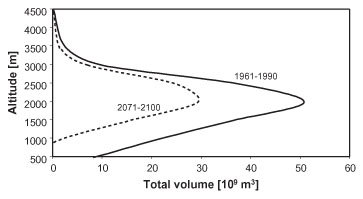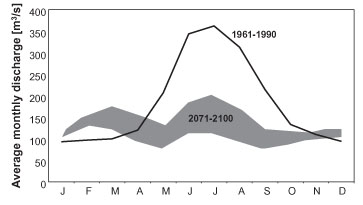 |
|
|
|
|
|
|
Altered temperature regimes usually also affect precipitation regimes. Due to higher winter temperatures, the snowline is expected to move upslope, and more precipitation will fall as rain instead of snow, reducing the amount of snow also within the alpine zone (fig. 1). As snow cover retreats, surface albedo decreases considerably. Exposed dark ground absorbs more solar radiation than ground covered with snow, which amplifies warming and melt rates. |

1 - Changes in snow volume in the Alps at different elevations between the current and scenario climates, assuming a 4°C temperature increase during winter (from Benistion 2012) |
|
Rising snow lines and overall reduced amount of snow will have a huge influence on surface hydrology and water resources in many parts of the world (fig. 2). |

2 - Monthly discharge of the Rhone river close to its mouth into the Lake of Geneva, near Montreux, Switzerland. Comparison between the recent past (1961-1990) and a future scenario (2071-2100, IPCC A2 emissions scenario). The gray shading delimits the possible range of discharge, according to the timing and volume of snow-melt, estimates of glacier retreat, and shifts in seasonal precipitation (from Benistion 2012) |
|
Besides its effects on albedo and hydrology, snow is an important insulator for many plants and soil biota and helps to protect against cold winter temperatures. This insulation often allows biochemical and microbial processes to continue when temperatures above the snow are well in the freezing range, and may protect plants from root injuries. Accordingly, a reduction in snow cover due to snow manipulation experiments led to reduced growth in a variety of plant species. Changes in precipitation are expected to vary greatly between regions. Higher temperatures will result in higher water content in the atmosphere, leading to an increase in orographic precipitation. In Europe, precipitation is expected to increase mainly in winter and in the north but to decrease in summer and in the southern regions. In addition to changes in the amount of precipitation, extreme weather conditions like longer heat weaves, dry spells, and strong precipitation events are likely to become more frequent. Also high intensity precipitation events are predicted to increase in frequency. Events related to variations in precipitation, such as snow avalanches and upland river floods, already increased in frequency and magnitude in many areas. |
13 August 2018 |
||
| |
||